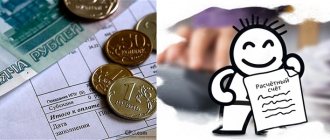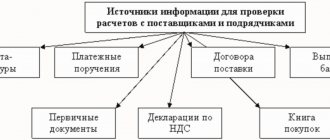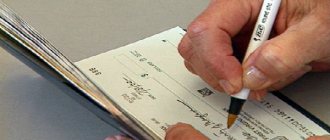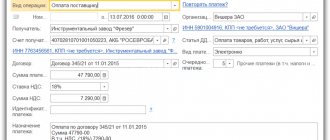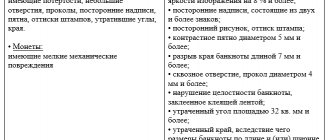Is optimization always beneficial?
VAT is included in the cost of a product or service; it is an indirect tax. He comes to the company when purchasing and leaves when selling. If you, as a seller, added VAT to the cost of a product and sold it, you cannot keep this tax for yourself - it must be given to the state. But often companies find it difficult to part with revenue, and various schemes appear that help reduce VAT or pay it back later.
VAT is the second most difficult tax to calculate, so its optimization schemes are not simple and not always legal. But even if the scheme does not contradict the law, the tax authorities look at it with dissatisfaction and make claims for it.
Also, when working with VAT, you must take into account that other companies also calculate VAT. And if you optimize the tax, it may be unprofitable for your counterparties. For example, if you are a seller and do not charge value added tax, your buyer will not be able to recover the VAT - he may refuse the transaction or request a discount of around 20%. If your customers are a large business that mainly works with VAT, then without this tax they are of little interest to you.
If you pay VAT, it is also beneficial for you to work with suppliers who pay this tax. Working with non-payers will bring you less profit, unless they agree to give a discount in the VAT rate.
If you conduct different areas of your business - taxable and non-taxable - you will have to keep separate records, and this is not always profitable. If a preferential direction without VAT brings in relatively little income, then all the funds saved on VAT can be used to pay for the work of an accountant. With separate accounting, he will have more work.
Calculation of VAT on advance payment and issuing an invoice to the buyer
For the purposes of calculating VAT, the moment of determining the tax base is the earliest of the dates (clause 1, clause 1, article 167 of the Tax Code of the Russian Federation):
- date of payment for upcoming deliveries;
- Shipping date.
Therefore, upon receipt of an advance payment, VAT must be calculated. For this, calculated rates of 10/110 and 18/118 are used, depending on the rate at which subsequent shipment will occur (clause 4 of Article 164 of the Tax Code of the Russian Federation).
For example, an advance of 30,000 rubles was received. for the upcoming supply of goods subject to VAT at a rate of 18%. Within 5 calendar days after receiving the advance, VAT should be charged at the calculated rate of 18/118 in the amount of RUB 4,576.27. (clause 3 of article 168 of the Tax Code of the Russian Federation).
But this is ideal. Often in practice there are much more complex situations when the advance received cannot be attributed to certain goods, which means we do not know exactly at what rate the shipment will be made - 10% or 18%. In such cases, it is safer to charge VAT at the calculated rate of 18/118, indicating in gr. 1 invoice of a generalized name of goods (Letter of the Ministry of Finance of the Russian Federation dated 03/06/2009 N 03-07-15/39).
Please note: if VAT on advances was calculated based on the assumption that the shipment will be subject to VAT of 18%, but was actually shipped at a rate of 10%, only the VAT on the advance that is equal to the “shipped” tax, i.e. accrued, can be deducted at a rate of 10%. The remaining VAT can be returned or offset against future payments by submitting a clarification (Letter of the Ministry of Finance of the Russian Federation dated November 8, 2012 N 03-07-07/115).
Study the key points of filling out an advance invoice in 1C
For the amount of calculated VAT on the advance received:
- in the sales book, a registration entry is made for the advance invoice with transaction type code 02 “Advances received”;
- In accounting, the entry Dt 76.AV “VAT on advances and prepayments” Kt 68.02 “Value added tax” is generated.
Accounting in 1C
The calculation of VAT on prepayment is carried out using the document Invoice issued as a transaction type for advance payment.
In 1C there are two main options for creating an invoice for an advance received from the buyer:
- based on the payment receipt document - with the Create button based on - Invoice issued ;
- using processing Registration of invoices for advance payments in the section Bank and cash desk – Registration of invoices – Invoices for advance payments.
In the example, we will fill out the document Invoice issued for an advance payment automatically based on the document Receipt to the current account .
Please pay attention to filling out the fields:
- Invoice No. - the number of the invoice issued to the buyer. Installed automatically in chronological order;
- from – date of the invoice issued to the buyer. By default, the advance payment date is indicated; if necessary, you can change it manually;
- Payment document No. from – number and date of the buyer’s payment order. Filled in automatically according to the data in the fields According to document No. from the base document, if necessary, you can adjust or specify manually.
Mandatory indication of the number and date of the payment order is regulated by clause 5.1 of Art. 169 of the Tax Code of the Russian Federation and paragraphs. clause 1 of the Rules for filling out an invoice, approved. Decree of the Government of the Russian Federation dated December 26, 2011 N 1137).
In the section Explanation of the amount according to VAT rates it is indicated:
- Nomenclature - the name of the product indicated in the buyer's invoice , since payment from the buyer was made on the basis of the invoice;
- Contents of the service, additional information - filled in manually only if it is necessary to clarify the Nomenclature . Then the data from this column will appear on the printed invoice form;
- Amount – prepayment amount;
- Transaction type code - 02 “Advances received”;
- Issued (transferred to the counterparty) – the date of transfer of the advance invoice to the buyer.
Postings according to the document
The document generates transactions:
- Dt 76.AV Kt 68.02 – calculation of VAT on the advance payment transferred by the buyer.
The document generates movements in the VAT Sales :
- registration entry on the advance invoice for the amount of calculated VAT;
- registration entry on the advance invoice with the number and date of the payment document.
Sales Book report can be generated from the Reports – VAT – Sales Book section. PDF
Documenting
You can print the completed invoice form by clicking the Print document Invoice issued . PDF
VAT declaration
The VAT return reflects the amount of VAT calculated on the buyer's advance payment:
On page 070 “Amounts of payment received, partial payment...” of Section 3: PDF
- the amount of the prepayment received, incl. VAT;
- calculated VAT amount;
In Section 9 “Information from the sales book”:
- invoice issued, transaction type code "".
For the continuation of the example, see the publications:
- Sales of goods
- Acceptance of VAT for deduction when offsetting an advance payment
See also:
- Invoice issued transaction type For advance payment
- Procedure for filling out advance tax returns
- p. 070 Advances received from customers
Did the article help?
Get another secret bonus and full access to the BukhExpert8 help system for 14 days free of charge
Related publications
- How to transfer an advance from one contract to another? ...
- How to deduct VAT on an advance received from a reorganized company at the time of shipment of goods to the legal successor? ...
- Acceptance of VAT for deduction when offsetting advances received from buyers Let's consider the features of reflecting in 1C the acceptance of VAT for deduction when...
- We received an advance on December 31, the advance SF was issued on the first working day of 2021 - is this a violation? ...
Accurate accounting to reduce VAT
The amount of VAT depends on proper accounting. To avoid an overestimated tax amount by the end of the quarter, follow these rules:
- add all incoming acts, invoices and invoices to your accounting system;
- request advance invoices from suppliers;
- issue invoices to customers;
- check that all invoices received from suppliers are posted in the system;
- check that the system has not calculated VAT twice: to do this, check the link to accounts and contracts in incoming payment orders and outgoing acts and invoices;
- check the same in outgoing payment orders and incoming acts and invoices.
Web service for small and medium-sized businesses Kontur.Accounting will automatically check all VAT items in order to minimize the amount payable. The service will tell you what exactly needs to be done or checked in accounting.
Receipt of advance payment from the buyer
The actual payment by the buyer, which was made according to the bank statement, is reflected in the program by the document Receipt to the current account, transaction type Payment from the buyer, in the Bank and cash desk section - Bank - Bank statements - Receipt button.
Please pay attention to filling out the document fields:
- Invoice for payment – the invoice on which payment was made, since in our example an invoice for payment was issued;
- According to document No. dated – the number and date of the buyer’s payment order, according to the bank statement.
BukhExpert8 advises filling out the number and date of the buyer’s payment order in the document Receipt to the current account to automatically fill out Payment document No. from the document Invoice issued for advance payment . It is these data that fall into page 5 “To the payment and settlement document No.__from__” of the invoice and, therefore, are indicated in gr. 11 “Number and date of document confirming payment” of the sales book. PDF
- Debt repayment – Automatically . With this method, the program automatically determines the payment status: advance or repayment of debt for settlements with the specified Payer in the context of the concluded Agreement .
Find out more about recording the advance received from the buyer in accounting
Postings according to the document
Due to the fact that there was no debt from the buyer of Architectural Workshop LLC under supply agreement No. 79 dated September 27, 2018, the amount received will be classified by the program as an advance:
- Dt Kt 62.02 – advance payment received from the buyer.
Working in special mode
You don’t have to pay VAT at all, as well as property and profit taxes. To do this, switch to a special regime: simplified tax system, PSN (for individual entrepreneurs), unified agricultural tax or UTII (cancelled from 2021). Instead of paying multiple taxes, you'll pay one at a lower rate. Compare your tax burden across different tax regimes using our free calculator.
Each special regime has restrictions on revenue, participation of other companies in the authorized capital, type of activity, cost of fixed assets, number of employees, etc. Be careful when switching to a special regime: if it turns out that you do not have the right to use it, the tax office will transfer you to OSNO , will assess additional taxes and fines. Accounting will also have to be restored.
With the main system (on which you have to pay VAT), you can combine special modes: PSN, Unified Agricultural Tax, UTII (until it is closed). And some special modes can be combined with each other: simplified tax system + PSN, simplified tax system + UTII, simplified tax system + ESKHN. You will have to keep records and submit reports separately for each mode.
To also get rid of VAT, at least parts of the business are often divided into several legal entities or individual entrepreneurs: one of them works with VAT, the other does not. The risk of such optimization is that the tax authorities may consider this a fragmentation of the business. Then all directions will be combined into one, which by default will work on OSNO, additional taxes will be assessed, and fines will be imposed. And if at the same time the Federal Tax Service discovers a tax arrears of more than 5 million rubles, a criminal case may be initiated against you (Article 199 of the Criminal Code of the Russian Federation).
Keep records of exports and imports in the Kontur.Accounting web service. Simple accounting, payroll and reporting in one service
Blog about taxes by Vladimir Turov
Good afternoon, colleagues!
Tax officers have learned to work efficiently. Between 2007 and 2017, the efficiency of inspectors in collecting arrears, penalties and fines increased by 56%. Let's see what awaits businessmen in 2021, and also figure out how to protect your business and legally reduce taxes.
For example, in 2021, the effectiveness of inspections increased by 22% (compared to 2021), and in 2021 by 18% (compared to 2018). The average price tag for penalties during inspection is also growing:
- in 2021 – 22.5 million rubles;
- in 2021 – 32.5 million rubles;
- in 2021 – 35 million rubles.
I can give a lot of statistics on this matter, especially based on the closed speech of the head of the Federal Tax Service of Russia.
When tax authorities invite OBEP, the effectiveness of inspections, according to their own statistics, increases 7 times! This was not enough for the inspectors. And from January 1, 2021, it is planned to involve the FSB of Russia to carry out control measures and operational inspections together with tax authorities. Do you think that's all? No.
The head of the Federal Tax Service of Russia announced the creation of 100% electronic document management for all legal entities, and then for individuals. At least at the first stage, all B2B transactions will be carried out electronically. This means that tax authorities will no longer request documents, because they will have all the primary documents. This indicates connectivity with the new version of ASK VAT-2, launched on June 1, 2020. The tax authorities will have all the chains of transactions. Add here that from July 1, 2021, ASK VAT-2 will be “intertwined” with labeling and invoices, as well as online cash registers and much more.
Mr. Egorov also spoke about the introduction of new tax regimes to replace the existing ones, according to which inspectors will see every transaction and collect taxes automatically.
I didn’t invent anything or exaggerate, I hope no one will scold us for this. You can throw rotten tomatoes at me and say: “No, you are again advertising your seminars so that we will pay you.” Whether we like it or not, we will live in this new world, and taxes will have to be paid on every transaction.
Recently I met with people who know everything about cashing. When I asked them what would happen to cashing out in 2021, they said they didn’t know. Thanks to the new regulatory framework, tax authorities can block everything.
What am I offering?
We are launching a New Year's game. From November 20 to December 20, 2020, you can choose a business subscription and reduce taxes yourself. You can also optimize your business under the supervision of my consultants. This isn't some stupid sale.
I announce such a game at the end of every year. We are launching business passes with discounts of up to 50%. You will receive a regulatory framework contained in a three-volume book, as well as implementation kits, which are written in understandable language. They contain all the steps to optimize your business, explanations and regulatory framework. You can choose the method that suits you and implement it yourself. And in the coolest subscription , you can reduce taxes with the support of my specialists.
In conclusion, I will say what I told the guys who know how everything is done in our country. I say: “Guys, let’s do this: I’ll tell you my dream now, and you tell me yours. If our dreams regarding Russia coincide, then we will see how we can cooperate.”
The reason why I was inspired by the idea of legal work with minimal taxes almost 20 years ago is very simple. I'm tired of the mess in our country, when some people catch others, then others catch others. When there is a cycle, who will deceive whom more: the state of taxpayers or vice versa. According to the guys I met: “at the top” there is complete confusion. They also don’t know what to do or what will happen next.
My dream: to make sure that businessmen pay all taxes legally, but at the same time spend the minimum that the law allows. But people also need to know that their money is not being stolen. So that entrepreneurs can say to every official, tax official or policeman: “You are a hired manager, you eat and drink only because I pay taxes. You walk on this asphalt and get treatment at the clinic because I pay taxes. I'm proud that I pay my taxes. And you, hired manager, please be proud of the fact that you provide me with quality service. We hired you so that you could provide us with quality service and not create problems.” This is my sincere dream.
In modern intelligence services and law enforcement agencies there are also people who are tired of this mess. They also want order in our country. When the government would respect the taxpayer, and the taxpayer would respect the government. On this, these guys and I agreed and agreed that we would cooperate.
I hope that we will live to see this time. To reduce the pain that you will have to go through when Mr. Egorov begins to “whitewash” you, do not be lazy, check out the subscriptions . 2021 will not be an easy year for business. The pandemic has hit entrepreneurs hard. It's time to turn things around and make 2021 the year of growing income and low taxes.
With our holiday passes you:
- you will be able to reduce income tax, insurance premiums, and in some cases even VAT;
- protect your assets and have legal cash;
- build a structure in which taxes will be minimal and the business will be safe.
We are launching 3 types of business subscriptions: “Light” , “Standard” and “VIP” . Each of them includes consultation with an expert who will help you create a program to achieve maximum benefit and security for your business.
What is included in the “Light” subscription:
- online intensives;
- 4 sets of documents to choose from;
- one-hour consultation with our expert;
- 10% discount on any products and services for 2021.
What is included in the Standard subscription:
- online intensives;
- 6 sets of documents to choose from;
- two-hour consultation with our expert;
- 15% discount on any products and services for 2021.
What is included in the VIP subscription:
- Bootcamp;
- online intensives;
- introduction of any method of tax optimization or a set of documents “Production cooperative”;
- two-hour consultation with our expert;
- 20% discount on any products and services for 2021.
We have divided the prices in half. Also, only in these subscriptions you can buy documents for self-implementation. If you take advantage of our offer, you will save a lot and make 2021 calm, profitable and successful.
SELECT SUBSCRIPTION
We are against cashing out and illegal tax reduction schemes.
We are for legal business and encourage all businessmen to work in accordance with the laws of the Russian Federation.
(Visited 347 times, 1 visits today)
Vladimir Turov
Head of legal practice, practicing and leading specialist in tax planning, building individual tax schemes and holdings, optimizing financial flows.
VAT exemption
Companies without import operations and excisable goods can submit an application and be exempt from paying VAT on certain operations or activities (Article 145 of the Tax Code of the Russian Federation). To do this, a condition must be met: the company’s revenue excluding VAT should not exceed 2 million rubles for three consecutive calendar months. If this limit is exceeded, the right to the privilege “burns out.”
There is also an exemption from VAT for certain types of goods and services (Article 149 of the Tax Code of the Russian Federation). These include medical services, care for the disabled, child care, arts services, and research and development. Study the list of operations in Art. 149, you may find your products or services there.
Reduced VAT rates
In most cases, the VAT rate is 20%, but for some goods and services it is reduced to 10% and 0%.
- 10% VAT applies to food products, medications and other medical goods, school supplies, children's clothing (clause 2 of Article 164 of the Tax Code of the Russian Federation);
- 0% VAT is applied for international transportation services and export products (Clause 1, Article 164 of the Tax Code of the Russian Federation). The “zero” rate does not relieve you of the obligation to maintain documentation: issue invoices, fill out and submit VAT returns.
Step-by-step instruction
Attention! The VAT rate has been changed from 01/01/2019 from 18% to 20% and from 18/118 to 20/120.
On September 30, the Organization’s bank account received an advance payment from the buyer of Architectural Workshop LLC for office furniture in the amount of RUB 354,000. (including VAT 18%). An advance invoice is issued to the buyer on the same day.
Let's look at step-by-step instructions for creating an example. PDF
| date | Debit | Credit | Accounting amount | Amount NU | the name of the operation | Documents (reports) in 1C | |
| Dt | CT | ||||||
| Receipt of advance payment from the buyer | |||||||
| September 30th | 51 | 62.02 | 354 000 | 354 000 | Receipt of advance payment from the buyer | Receipt to the bank account - Payment from the buyer | |
| Calculation of VAT on advance payment and issuance of tax invoice to the buyer | |||||||
| September 30th | 76.AB | 68.02 | 54 000 | Calculation of VAT on advance payment and issuance of tax invoice to the buyer | Invoice issued for advance payment | ||
| — | — | 54 000 | Reflection of VAT in the Sales Book | Sales book report | |||
For the beginning of the example, see the publication:
- Issuing an invoice to the buyer and receiving an advance from him
Loans
With the help of loans, you can defer the payment of VAT for a quarter or more. To do this, the seller takes a loan from the buyer equal to the advance amount. After shipment, the debt for the goods sold and the loan are offset. Since loans are not subject to VAT, tax will only be charged on the sale of goods.
This scheme does not break the law, but it does have its risks. Firstly, the tax office is well aware of the scheme and is wary of it, so it will not be possible to use this technique regularly. Secondly, it is not profitable for the buyer to postpone the tax payment deadline or give a loan, so it is important to take into account the interests of the buyer.
How to calculate VAT payable
It is important to understand what this type of tax is. It is added to the cost that was added to the entrepreneur’s goods. The taxpayer may be:
- Absolutely any enterprise or firm;
- Entrepreneurs;
- Citizens who were recognized as taxpayers due to the transportation of goods across the border.
When calculating such a tax, the following documents are provided: a contract concluded with a Russian or foreign company. Papers that confirm the completion of services.
This tax may have different rates:
- 0 percent – applies to the sale of medicines or social products;
- 10 percent is a reduced rate. Children's goods, food, stationery, and printed publications can be sold here;
- 18 percent – the rate is applied when the product does not apply a rate of 0 or 10 percent.
It is important to ensure that there is no overpayment. You need to clearly know how to calculate VAT payable, and you must follow some rules.
- This type of tax represents the difference between the cost that the company needs to pay for the products sold and between what it is forced to pay when purchasing the products.
- In order to report VAT for payment to the budget, you must submit a return to the tax service on time.
To make the calculation you need to do the following:
- First you need to determine the retail price of the products.
- Next, the VAT liability is calculated. To determine it, you need to multiply the tax base with the VAT rate.
- Then you need to find out the amount of input VAT, by which the taxpayer must reduce his liabilities. It includes amounts paid to the budget after purchasing products or services.
- After which the amount of VAT is calculated, which is the difference between the liability and the input tax.
- The last step is to fill out the declaration. All amounts received are indicated here. Such a document is submitted to the tax authority.
All information about input VAT is entered into the purchase book, outgoing VAT is entered into the sales book, and their difference is recorded in the declaration. This document is submitted to the tax authority at the end of the quarter, no later than the 25th day following the reporting quarter. If an entrepreneur does not submit a return on time, the tax office imposes a fine on him.
Including shipping amount in price
If you sell goods subject to a 10% VAT rate, it is beneficial for you not to allocate the delivery amount (where the tax rate will be 20%), but to include the costs of transporting the goods to the buyer's warehouse. Then you will pay 10% VAT on the entire cost of the goods, and for the services of transport companies you will deduct 20%. To apply this scheme, state in your accounting policy that the cost of goods includes delivery costs, and in the contract with the buyer indicate that delivery is included in the price of the goods.
Work with VAT in the Kontur.Accounting web service. The system makes it easy to keep records, pay salaries, and report online. The service will help you optimize VAT and tell you how to reduce your payment. The first two weeks are free for all new users
